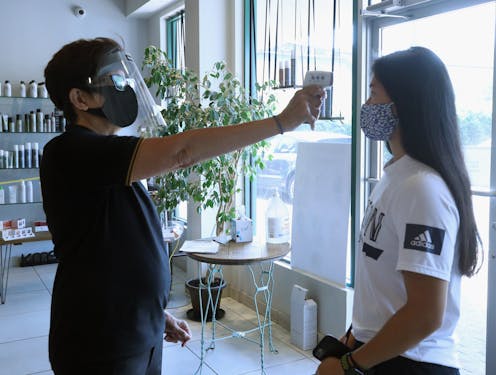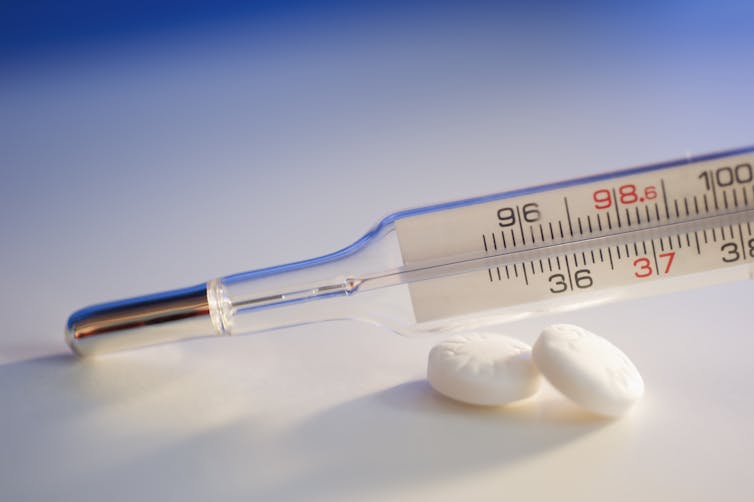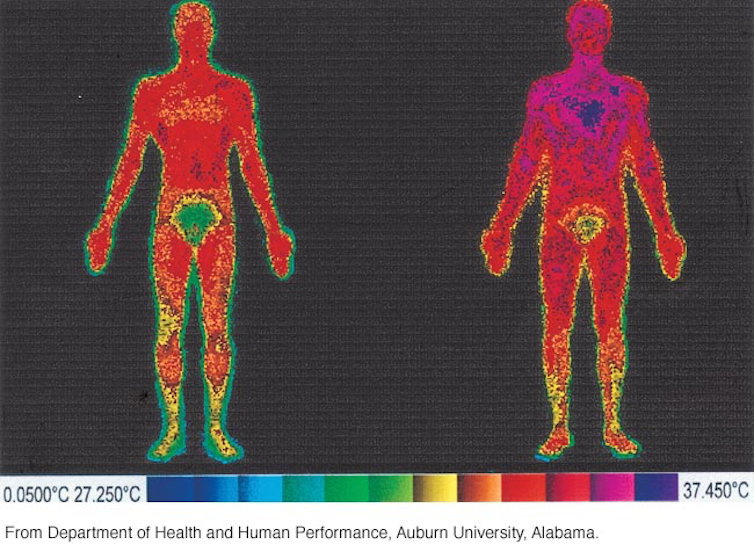'Normal' human body temperature is a range around 98.6 F – a physiologist explains why
'Normal' body temperature varies from person to person by age, time of day, where it's measured, and even menstrual cycle. External conditions also influence your thermometer reading.

Fever is common in the symptomatic stage of COVID-19, and as workplaces and child care spaces reopen, temperature checks are one way officials are trying to identify those sick with the coronavirus. To maintain no-contact conditions, many are scanning skin temperature.
As warm-blooded animals, human beings produce heat as a byproduct of the chemical reactions that provide energy from the food we eat. It’s this heat that keeps human bodies within a fairly narrow range of “normal” body temperatures and our biology works best within this small “normal” range.
But, as a physiologist, I know there are a variety of factors – both internal and external – that can influence your temperature. “Normal” might be less universal than you think.
Normal, with a bit of flex
Quick, what’s a normal body temperature? Almost certainly you’d answer 98.6 degrees Fahrenheit (37 degrees Celsius). Despite that number being common knowledge, the answer is actually more complicated.

Many trace this number back to an 1871 book on medical thermometry by a German physician named Carl Reinhold August Wunderlich who measured the underarm temperatures of thousands of people. Readers seem to have taken away the monolithic 98.6 number, but Wunderlich in fact wrote that based on his measurement “healthy persons under varying conditions” had temperatures that ranged from 97.16 F to 100.4 F.
Even accounting for that variation, a recent study suggested that, across the population, core temperatures have declined about 0.6 F (0.3 C) below the traditionally accepted levels and about 0.85 F (0.5 C) compared to the end of the 19th century and beginning of the 20th century.
The researchers acknowledge these observed reductions could be the result of changes in equipment and measurement technique. But they suggest the reduction could also reflect physiological shifts in metabolic rate and reductions in inflammation related to underlying medical conditions that people manage more effectively now than in the past.
A temperature reading will differ depending where on the body you measure it; some of the common sites include in the mouth, in the ear, under the armpit, on the forehead, or rectally. Each of these locations will have slightly different normal values. Temperature measurements – like oral or rectal – taken closer to the sites of more energy use and will produce more heat, resulting in higher temperature readings.
Measurements taken at sites close to the body’s surface – like the ear or skin – are influenced by the surrounding environment and will tend to be lower. This is one reason skin temperature might not be a foolproof screening tool for COVID-19. Someone who’s been in a cool environment may falsely screen negative for fever, while someone who’s been rushing outside in the sun may falsely screen positive.
Keeping your body warm and working
Body temperature is a byproduct of your metabolism. Metabolism is the way your body turns fuel – the carbohydrates, fats and proteins from the food you eat – into usable energy. This process is only about 25% efficient, so as chemical bonds are broken, the majority of their energy gets released as heat.
Your body’s temperature is based on the heat from your energy production. Digesting food, physical activity and infection increase the metabolic rate and can all raise your temperature.
Babies may have slightly elevated normal body temperatures and caloric needs as a result of increased metabolic rate to support growth and development, while seniors may have slightly lower body temperatures due to lower rates of cellular growth and repair.
In addition to changes that occur as the result of age, everyone has variation throughout the day based on their circadian rhythms. Both the 1871 book by Wunderlich and more recent research have demonstrated that people typically experience their lowest body temperatures overnight. Similarly, body temperature will fluctuate through the varying phases of females’ menstrual cycle.

When things heat up
Medical practitioners generally classify fever as a temperature greater than 100.4 F (38 C), as measured rectally in both adults and children. Oral temperatures of 99.5 F and under-the-arm temperatures of 99 F, are considered fever in children.
While some may try to reduce fever, higher temperatures seem to provide an advantage in fighting infections and are actually part of your body’s natural immune response. One possible physiological benefit is that fever helps keep pathogens from replicating and can destroy them. Most human pathogens reproduce best at temperatures below 98.6 F and they have increasing troubles as the temperature in your body goes up.
Elevated body temperature aids the body’s immune system by increasing the activity of the cells and processes that identify, attack and remove the invaders. So, fever works to reduce the spread of the pathogen while also increasing the damage to the pathogens already in the system.
Unfortunately, your organs also have preferred temperature ranges that allow them to properly function. At excessive body temperatures, your own proteins and structures can be damaged. Temps that high can be fatal.

Exercise will also raise your body’s core temperature at increasing rates with rises in intensity. Increased energy production leads to increased heat gain in the body. When you’re physically active, your muscles require additional energy to contract. At one extreme, to complete a sub-two-hour marathon, Eliud Kipchoge needed about 20 times more energy compared to resting level.
Environmental conditions – such as temperature, humidity and wind – play a role here. The body functions best at moderate temperatures. However, people have adapted to living in extremes by using clothing and shelter. A cold environment can lead to unsafe declines in body temperature. Hot and humid conditions can allow body temperatures to reach unsafe high levels. Excessive body temperatures due to fever, intense physical activity, heat exposure or a combination can cause cellular damage that can rapidly progress to death.
So while everyone’s body temperature is not necessarily 98.6 F, your “normal” is still pretty close to this average value. Human beings live in a very narrow survival zone. Significant deviations from average in this tightly controlled physiological variable can quickly become life-threatening.
[You’re smart and curious about the world. So are The Conversation’s authors and editors. You can read us daily by subscribing to our newsletter.]
JohnEric Smith does not work for, consult, own shares in or receive funding from any company or organization that would benefit from this article, and has disclosed no relevant affiliations beyond their academic appointment.
Read These Next
From truce in the trenches to cocktails at the consulate: How Christmas diplomacy seeks to exploit s
World leaders like to talk up peace at Christmastime. But alongside the tales of seasonal breaks in…
The world risks forgetting one of humanity’s greatest triumphs as polio nears global eradication − 7
Polio may finally be defeated in the next 5 years. Will the world recognize what an extraordinary achievement…
Medieval peasants probably enjoyed their holiday festivities more than you do
The Middle Ages weren’t as dreary and desperate as you’d think, and peasants often had weeks of…





